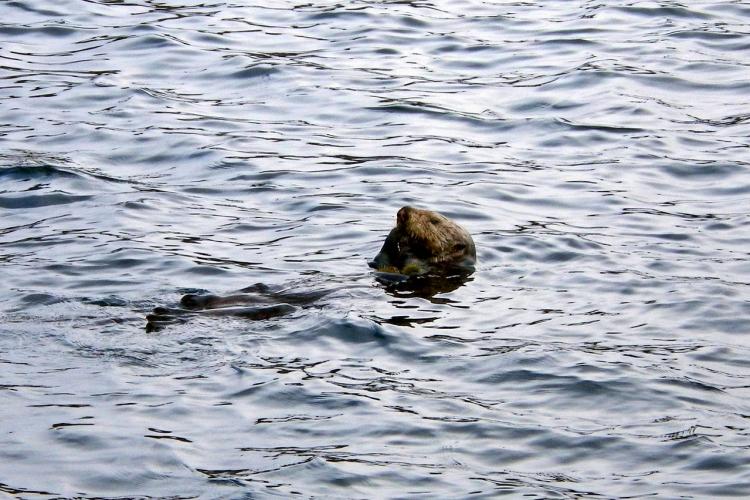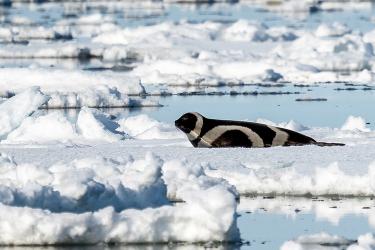A possible predator on our crabs at the dock! Sea otters will feed on a variety of prey, but prefer to eat sea urchins. Otters promote a healthy diversity of vegetation and animals in rocky areas by keeping the sea urchin populations in check, which allows the kelp and algae the urchins feed on to thrive. This, in turn, provides habitat and food for a variety of other animals. Fortunately, this otter was observed feasting on sea urchins and seemed uninterested in the end of the dock where our lantern nets are hung. Hopefully, the barricade fencing will discourage him if he discovers our crabs.

Sarah Johnson (Alaska Department of Fish and Game Observer) (left), Jeff Cox (Bering Sea Fisheries Research Foundation), Pam Jensen (NOAA Fisheries) preparing food for crab. Sarah, Jeff and Pam are cutting cod scraps into chunks and threading them onto bamboo skewers. The skewers keep the pieces of cod from washing out of the nets as they are lowered into the water.

Brian Crooks (Bering Sea Fisheries Research Foundation, in black jacket), Dan Urban (NOAA Fisheries, in red jacket) and Jeff Cox (Bering Sea Fisheries Research Foundation, in gray hoodie) deploying lantern nets. We placed crabs in "crab condos," a series of strung together plastic containers and in lantern nets. Lantern nets are arrays of stacked, netted compartments, and hung off a dock at a depth of approximately 40 feet. The lantern nets house larger crabs that would be difficult to hold in the plastic crab condos. The lantern nets are surrounded by orange barricade fencing to discourage sea otters, seals and sea lions from snacking on our experiment!

We retrieve the lantern nets daily and each crab is checked to see if it has molted (shed its shell). We modified the lantern nets by attaching sheets of plastic to each compartment to act as flooring, providing a surface for the crabs to push against as they molt. We allow the shells of newly molted crabs to harden before we measure the new size. There are no new shell crab in this lantern net today.

Sarah Johnson (Alaska Department of Fish and Game Observer) feeding crabs. Sarah is placing cod kebabs in lantern nets for the crabs. While crabs do not normally feed on live cod, they will accept a free fish dinner—perhaps a little revenge on the cod, which is a predator of crabs.

Jeff Cox (Bering Sea Fisheries Research Foundation) (left), Pam Jensen (NOAA Fisheries), Sarah Johnson (Alaska Department of Fish and Game Observer), and Nick Ellickson (Alaska Department of Fish and Game Observer) measuring molted crabs. Jeff, Pam, Sarah and Nick have retrieved a lantern net and have hung it on a ladder for easy access at the dock. Jeff has removed a new-shelled crab from its compartment and is handing it to Sarah for measurement.

Tanner crab visible through lid of crab condo.

Tanner crab in crab condo.

Crab condos hanging in tank. The smaller crabs have been placed in the crab condos, and the condos are hung off lines that are strung across the tanks. To check daily on the crabs, we can look down through the water and the translucent blue lids and see the crabs. Sometimes the diatoms (algae) that settle out of the water onto the lids obscure the view of the crabs—then we simply grasp the PVC 'trunk' of the condo tree and rotate the tree up and sideways to allow the diatoms to fall off the lids. We can rotate the condos without lifting them out of the water and get a clear view of the crabs through the sides and bottoms of the condos.

Jeff Cox (Bering Sea Fisheries Research Foundation) removing crab condos from the tank. To measure a crab that has molted, Jeff is removing a condo tree from the tank. The new-shelled crab will be removed from its condo and then the condo tree will be returned to the tank. The crab will be measured and the data recorded for later analysis, providing information on crab growth rates for use in stock assessment models. These are models that predict the size and age distribution of the crab populations and allow us to estimate the amount (biomass) of crabs that the fishery can remove without overfishing.

Pam Jensen (NOAA Fisheries) (left) and Nick Ellickson (Alaska Department of Fish and Game Observer) measuring a new-shell Tanner crab. Nick measures the carapace width of the crab and Pam records data and verifies the species and sex initially recorded during project setup are correct. Because Tanner and snow crabs have a terminal molt to maturity, it is possible to determine sexual maturity by examining and measuring the crabs. Females undergo a readily observable change in the relative size and shape of the abdomen (tail) when molting to maturity. The claw size in males that molt to maturity undergoes a disproportionately larger increase in size than the claw of molting males that remain sexually immature. Therefore, we are also measuring claw height of the pre- and post-molt males and noting the shape of the abdomen on females.



